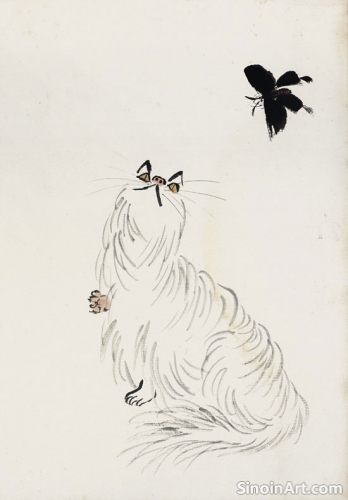Xieyi Painting and the Use of "Splash Ink"
|
"Splash Ink," or pōmò (潑墨), is a bold and expressive technique in Xieyi painting that involves applying ink in a free and spontaneous manner, often using a loaded brush to create large, sweeping washes. The goal is to capture a sense of movement and dynamism. It is a technique that prioritizes spontaneity and the uninhibited application of ink.  This technique often involves using the ink without precise control, allowing the ink to spread and blend naturally on the paper, resulting in unpredictable and expressive forms. The ink interacts with the paper in a way that highlights its fluid nature. It is a technique that values embracing the unexpected.  "Splash ink" is particularly effective for depicting landscapes, clouds, water, or other natural scenes where movement and fluidity are key elements. The effects are natural and highly organic. The results can be dynamic, atmospheric, and expressive of a wide range of emotions.  The application of splash ink requires both confidence and a good understanding of the ink's behavior. The artist must learn how to load the brush, how much pressure to apply, and how much water to use in order to achieve the desired effect. It is a technique that appears spontaneous, but also requires technical mastery. While pōmò may seem haphazard, it is often carefully planned and executed, with the artist strategically using the technique to achieve balance, depth, and a sense of vitality. It is the intentional use of spontaneity. It is about embracing the creative potential of the unexpected. |
Tag : Splash ink technique, Pomo, spontaneous ink, dynamic washes, Xieyi method
Related information
- Xieyi Painting as a Form of Personal Expression
- The Influence of Confucianism on Xieyi
- Xieyi and the Influence of Poetry
- Xieyi Painting and the Concept of "Shu Xing"
- Xieyi Painting and the Concept of "Gu Yi"
Xieyi painting is a deeply personal form of expression, allowing artists to share their inner world, interpret their subject matter freely, and create unique artworks that reflect their individual vision, emotions, and experiences, making it a vehicle for both artistic expression and self-discovery.
Confucianism subtly influences Xieyi painting through its emphasis on self-cultivation, social harmony, moral conduct, and the ideal of the gentleman scholar, shaping the cultural context, the values of the art form, and the ethical dimensions of artistic creation.
Xieyi painting is profoundly influenced by poetry, with literati artists integrating verse into their paintings, applying similar principles of rhythm and expression, and using symbolic imagery to convey complex ideas and personal feelings, emphasizing the interconnectedness of these art forms.
"Shu Xing" (calligraphic nature) is a core concept in Xieyi painting, emphasizing how the principles and techniques of calligraphy influence its brushwork, structure, and expressive qualities, reflecting the shared tools, values, and emphasis on balance, rhythm, and a sense of life force.
"Gu Yi" (ancient intention) in Xieyi emphasizes an artist's engagement with tradition, seeking to absorb the spirit and principles of past masters, studying their techniques and cultural context to create work that honors the legacy of the art form and contributes to its ongoing evolution.